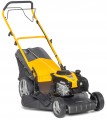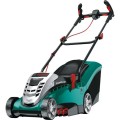Motor type
The type of engine that drives the cutting tool of the lawn mower, and in self-propelled models, the device itself. At the moment, the following types of engines are used:
— Electric (mains).
Mains powered motor. Its advantages are low noise level, low cost and ease of operation (no need to buy fuel and oil) and no emissions into the atmosphere. Among the shortcomings can be called a relatively small power and a short range, limited by the length of the power cord.
— Electric (battery). Electric motor powered by its own built-in battery. It has all the same advantages as a mains-powered motor; in addition, such devices are not limited in movement, since they do not require a network connection during operation. On the other hand, the battery life of
battery lawn mowers rarely exceeds half an hour, the battery weighs a lot and takes a long time to charge, and the power of such devices is even lower than that of network ones (despite the fact that they are noticeably more expensive).
—
Petrol. Gasoline internal combustion engine. The advantages of such engines, in comparison with electric ones, are independence from the mains connection and high power, which allows you to work with dense thick vegetation. On the other hand, gasoline engines are heavier, more expensive to run, require the purchase of fuel and lubricants, and emit exhaust gases into the
...air.
— Diesel. A type of internal combustion engine. In terms of basic features, diesel engines are almost identical to those described above, but they also have their own characteristics. On the one hand, in such units it is easier to provide high power and good torque, so they are better suited for "heavy" tasks; and diesel fuel is cheaper than gasoline. On the other hand, diesel engines themselves are more expensive, heavier and more difficult to operate. Therefore, they are not particularly popular among lawn mowers, this option is found mainly in riders (see "Type"), where high power is more important than the mentioned disadvantages.
— Gas. A rare variety of internal combustion engines that use a propane-butane mixture of gas as fuel. Their advantages over gasoline units are economical consumption, high mowing performance, and a small amount of harmful emissions into the atmosphere. In addition, gas fuel reduces the load on the engine, which, in turn, prolongs its operational life. The reverse side of the coin is the need to fill the cylinder with liquefied hydrocarbon gases at specialized filling complexes or the frequent replacement of gas cartridges.
— Without engine(manual). Lawnmowers that are not equipped with any motors and use the muscular strength of the user — when working, it is necessary to push the device in front of you. The advantages of such a scheme are low cost (both the device itself and its operation), independence from fuel and electricity, and maximum environmental friendliness; disadvantages are the relatively low quality of work and the significant expenditure of physical strength.Cutting width
The capture width provided by the unit, in other words, the width of the strip of land cultivated in one pass. In fact, this size corresponds to the width of the working nozzle.
The large working width is useful when processing large open spaces, as it allows you to finish the job in a small number of passes. On the other hand, for hard-to-reach places, relatively narrow tools are better suited, able to go where a wider unit will not fit. In addition, the width of the tool directly affects the weight and price.
In general, it makes sense to compare in terms of working width only units of the same type (see above). However, it is worth noting here that trimmers do not differ so much from each other — most models capture from 25 to 45 cm (and a wide processing band is provided by moving the nozzle from side to side). As for the other types, in the most modest models the capture width
does not exceed 40 cm, in the heaviest and most powerful it can be
56 – 60 cm or even
more(in mini tractors — up to 1.5 m).
Min. cutting height
The minimum cutting height provided by the lawnmower — that is, the smallest height of grass that can remain after the passage of the machine. It makes sense to pay attention to this indicator mainly in cases where the lawn is planned to be cut as short as possible. In addition, the lower the minimum height (with the same maximum), the wider the height adjustment range of this model.
Max. cutting height
The maximum cutting height that the lawn mower can achieve is the maximum height of grass that can be left after the machine has passed.
This parameter is relevant mainly for those cases when you want to leave the grass on the lawn relatively long. In addition,
lawn mowers with high cutting heights have a wide range of mowing adjustments.
Number of height settings
The number of cutting height settings provided by the lawn mower. The more such settings (with the same adjustment range) — the more accurately you can choose the mowing height. Note that in some robots (see "Type") this number reaches 30 or more with a range of 30 to 60 mm; in other words, you can select the height to the nearest millimetre.
Mulching
Possibility of work of a lawn-mower in the mode of a mulching.
Mulching is the chopping and automatic spreading of mowed grass over the site. This is one of the most convenient and at the same time practical methods of vegetation disposal. So, it does not need to be collected, and the resulting coating (mulch) performs a number of useful functions: it fertilizes the soil, reduces its heating and evaporation of moisture in hot weather, and also keeps the top layer loose.
Note that some lawn mowers allow you to use a nozzle purchased separately for mulching. However, such models are not included in this category: mulching in our catalog is indicated only for models that support this function out of the box.
Grass ejection
Direction of ejection of grass cut by the lawnmower.
The main options for the direction of ejection are back or sideways; there are also models in which you can choose the direction. At the same time, we note that in classic units, the ejection back is almost always carried out
into the bag(up to the point that when the bag is removed, the hole is automatically covered with a lid), but when the bag is ejected from the
side, it may not be — this is convenient, for example, when mulching ( see above).
Also note that riders (see "Type") have their own specifics: in units with rear discharge, after removing the bag, it is necessary to install a special plug, and then the cut grass will simply remain under the deck. In some
mini-tractors, a similar way of working (without a bag) is provided initially; it is also considered a rear ejection, although the grass does not flow backwards, but downwards.
Bag type
A type of bag used in a lawn mower to collect grass clippings.
—
Hard. Bags (containers) made of a hard material, usually plastic. Such a container is more convenient to unload than a soft one, it is more durable and reliable, but it weighs a little more.
—
Soft. The advantages of soft fabric bags are primarily low weight and the ability to fold after hours, which can facilitate storage. In addition, the degree of fullness of such a bag can be controlled by eye without any special indicators. On the other hand, soft bags are very inconvenient to unload.
—
Combined. Bags that combine soft and hard materials in construction; the upper part is usually made solid. This combination makes it easier to unload the bag and at the same time allows it to be rolled up quite compactly for storage.
— Is absent. The absence of a bag is characteristic of some varieties of mowing units — in particular, mowers and trimmers (see "Type"). In classic lawn mowers, it usually means that this model does not involve collecting grass — all cut vegetation remains on the ground. At the same time, most of these models have the function of mulching (see above), however, there are exceptions.
Bag volume
The volume of the grass clipping bag supplied with the lawn mower. Manufacturers select this volume depending on the power, performance and overall level of the unit, however, similar models may differ in this indicator. In such cases, it is worth considering that a larger bag takes longer to fill and needs to be unloaded less often, but it weighs more and takes up more space (even when empty). Mostly the difference in the volume of the bag is 5 liters and there are
lawn mowers for 35,
40,
45,
50, 55,
60,
65,
70 and more liters.

